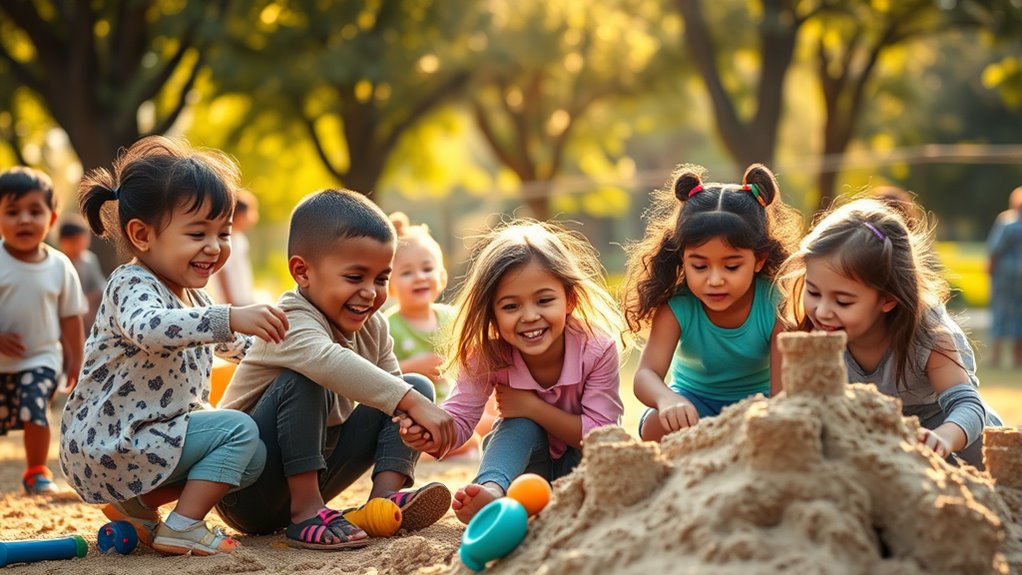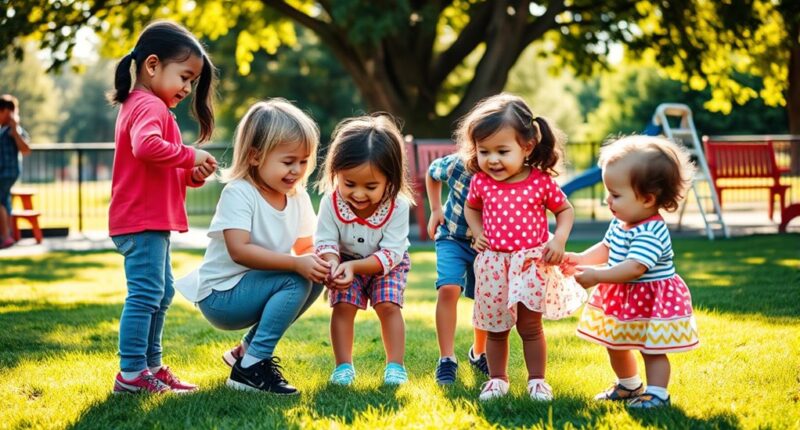To teach kids kindness quickly, model small acts of kindness daily, like holding doors or saying thank you. Discuss situations where empathy plays a role and share stories that highlight good deeds. Encourage kids to participate in community service, like volunteering at a food bank, to help them understand the impact of their actions. By nurturing gratitude and empathy in everyday life, you can reinforce the importance of kindness. There’s more to explore about fostering this essential value.
Key Takeaways
- Model small acts of kindness daily, such as saying thank you or helping others, to demonstrate positive behavior for kids to emulate.
- Engage children in community service activities, like volunteering at a food bank, to help them understand the impact of their actions on others.
- Discuss real-life scenarios where kindness is necessary, helping children differentiate between being kind and simply being nice to please others.
- Encourage specific expressions of gratitude by discussing what others have done for them, reinforcing appreciation and reciprocal kindness.
- Utilize stories and movies with themes of empathy to spark conversations about kindness and its effects on emotional well-being.

Teaching kids kindness isn’t just about telling them to be nice; it’s about showing them how to genuinely care for others. You can start by being a role model. Kids learn best through observation, so when you perform small acts of kindness—like holding the door open for someone or expressing gratitude for a service—your children will notice. They’ll begin to associate these behaviors with positive feelings. Make it a habit to talk about your good deeds and the joy they bring to others. This helps reinforce the importance of kindness in daily life and can also strengthen family bonds as children see their parents practicing empathy. Additionally, fostering emotional expression through activities will help children understand their feelings and the feelings of others, promoting a culture of kindness.
Engaging your kids in volunteer opportunities is another fantastic way to teach them kindness. By participating in community service projects together, you’ll help them understand the impact of their actions. Whether it’s serving at a food bank or cleaning up a local park, these experiences foster empathy and show kids the difference they can make in the lives of others. This hands-on approach is similar to how caregivers provide support while considering financial considerations for elderly care.
Participating in community service together helps kids understand the impact of their actions and fosters empathy.
It’s also essential to guide kids in distinguishing between being “kind” and merely being “nice.” Explain that kindness involves empathy and standing up for what’s right, rather than just trying to please others. You can frame this discussion around scenarios they might encounter at school or in social situations. This way, they’ll learn to navigate complex feelings and develop a deeper understanding of true kindness.
Incorporating discussions about gratitude can further reinforce the value of kindness. Encourage your children to express thanks not just in general, but for specific actions others have taken. This practice cultivates a sense of appreciation and teaches them that kindness is a two-way street. When they recognize the good in others, they’re more likely to want to reciprocate.
Lastly, utilize stories about kindness to inspire your kids. Books and movies that focus on themes of empathy and good deeds provide relatable examples that can resonate with them. After reading, discuss the key messages and how those characters showed kindness. This helps to solidify their understanding while allowing for meaningful conversations. Additionally, teaching kids about the importance of emotional well-being will help them understand how their acts of kindness can positively impact not only others but also themselves.
Frequently Asked Questions
How Do You Teach Kids Kindness?
Teaching kids kindness starts with modeling kind behavior yourself. Show them how small acts, like holding doors or helping with chores, can make a big difference.
Use specific language when you express gratitude, so they understand the connection between actions and appreciation. Encourage them to volunteer in community projects, which will deepen their empathy.
Ultimately, discuss that kindness can be challenging sometimes, but it’s important to try, even in tough situations.
What Is the Best Book to Teach Kindness?
When you’re looking for the best book to teach kindness, consider *Have You Filled a Bucket Today?* by Carol McCloud.
It introduces the concept of invisible buckets that can be filled with kindness or emptied by unkindness, making it relatable for kids.
You’ll find that its simple yet impactful message helps children understand how their actions affect others.
Plus, it’s engaging and encourages conversations about kindness in everyday life.
What Is the Kindness Circle Activities?
The Kindness Circle activity inspires sharing, fosters community, and cultivates empathy.
You’ll gather children in a circle, allowing each one to share a kind action they’ve performed or witnessed. Using a talking object, like a stuffed animal, guarantees everyone gets a chance to speak while encouraging active listening.
As they reflect on these moments, they’ll recognize the ripple effect of kindness, enhancing their emotional intelligence and reinforcing positive social behaviors among peers.
How Do You Raise a Kind-Hearted Child?
To raise a kind-hearted child, model kindness in your daily actions. Kids learn by watching you, so show compassion regularly.
Teach them to recognize emotions in themselves and others, helping them develop empathy. Get them involved in volunteer activities that spark their interests, and emphasize the importance of small acts of kindness.
Foster gratitude at home by discussing kindness during family meals or bedtime, reinforcing the impact of their actions on others.
Conclusion
In a world that often feels rushed, teaching kids kindness is like planting seeds of joy that bloom into beautiful relationships. By showing empathy, sharing, and encouraging compassion, you’re not just shaping their character; you’re creating a ripple effect that touches everyone around them. So, why not make kindness a daily adventure? After all, a little kindness goes a long way, turning ordinary moments into extraordinary memories. Embrace the journey, and watch as love spreads like wildfire.









